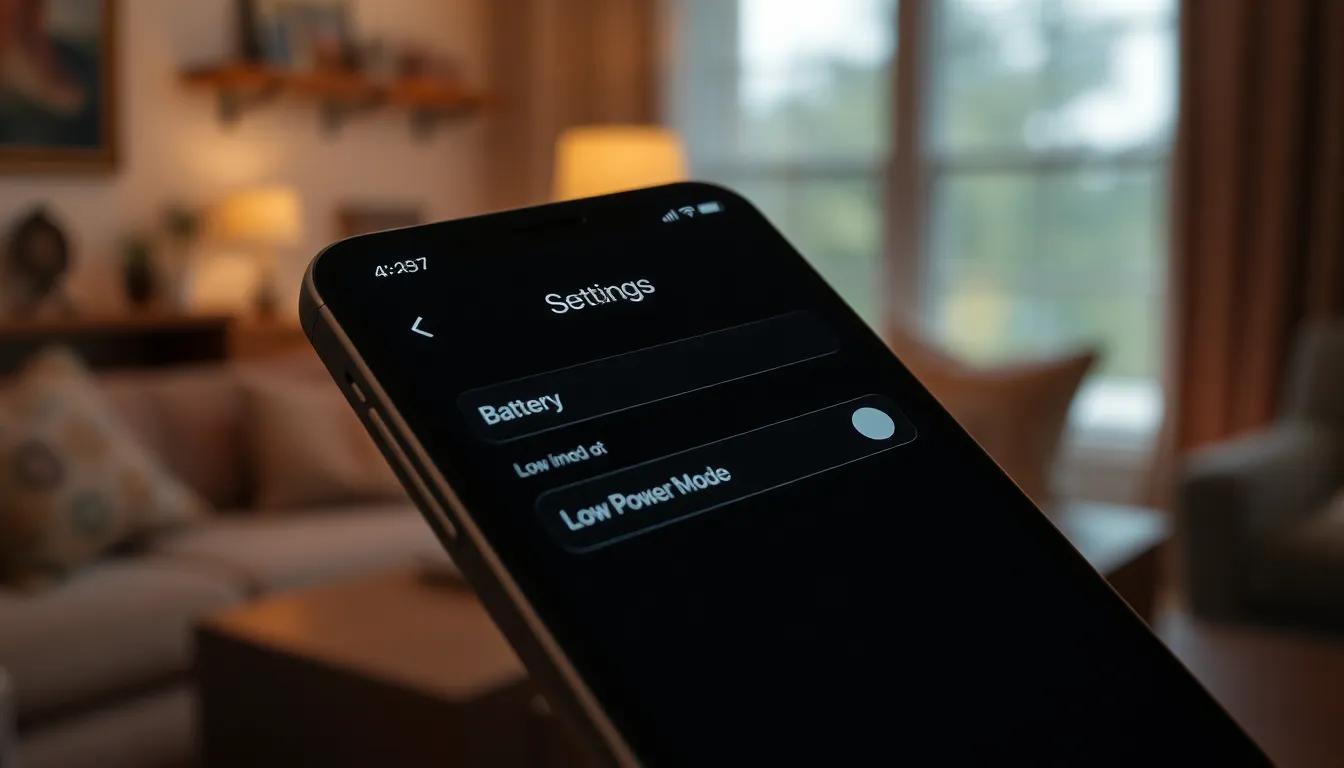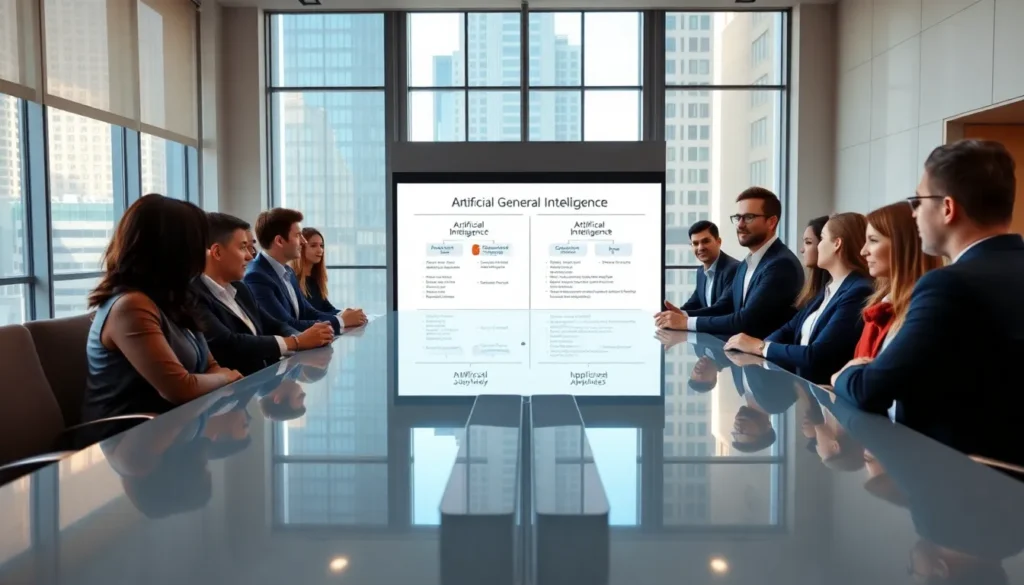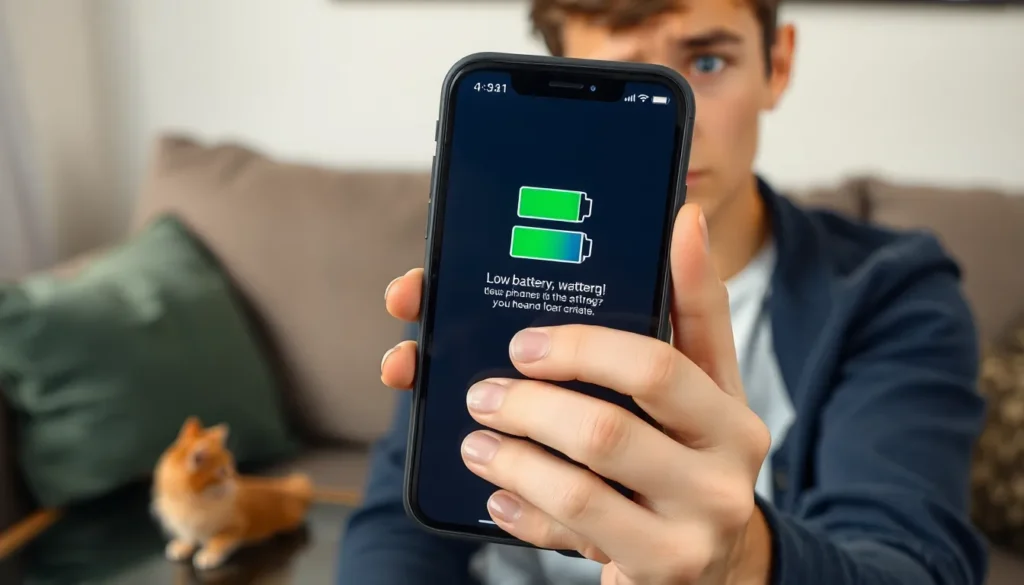Table of Contents
TogglePicture this: you’re out and about, scrolling through your favorite memes, when suddenly your iPhone flashes that dreaded low battery warning. Panic sets in. How will you survive without your daily dose of cat videos? Fear not, because activating low battery mode is easier than finding a parking spot at the mall during the holidays.
Understanding Low Battery Mode
Low Battery Mode is a feature designed to help prolong the battery life of an iPhone. Activating this mode conserves energy when battery levels drop, ensuring essential functions remain accessible.
What Is Low Battery Mode?
Low Battery Mode reduces background activity on an iPhone when battery power falls below 20%. This setting limits mail fetching, automatic downloads, and certain visual effects. Automatically, it lowers screen brightness and optimizes performance, helping users extend usage time until they access a charger.
Benefits of Using Low Battery Mode
Using Low Battery Mode offers several advantages. It preserves battery life during critical moments, such as when waiting for important calls or messages. Users often notice a decrease in background app refresh, minimizing power consumption. Activating this mode allows for greater efficiency with remaining battery life, providing reassurance while navigating low-power situations.
How to Enable Low Battery Mode on iPhone

Activating Low Battery Mode on an iPhone helps extend battery life efficiently. Follow the steps below to enable this feature based on your iOS version.
For iPhone Models with iOS 14 and Later
- Open the Settings app on the iPhone.
- Tap on Battery from the list.
- Select Low Power Mode and toggle it on.
This option quickly reduces background activity, ensuring battery preservation during critical moments.
For iPhone Models with iOS 13 and Earlier
- Access the Settings icon on the home screen.
- Scroll down and select Battery.
- Tap on the Low Power Mode switch to turn it on.
These steps function similarly, providing access to immediate battery savings when power runs low.
Customizing Low Battery Mode Settings
Customizing Low Battery Mode settings enhances the way it prolongs battery life on an iPhone. Users can tailor certain features to maximize efficiency when battery levels are low.
Notifications and Background App Refresh
Managing notifications and background app refresh plays a crucial role in optimizing battery usage. Disabling unnecessary notifications stops constant alerts from draining power. Background app refresh can also be turned off for specific apps to limit updates while Low Battery Mode is active. Users can navigate to Settings, tap on General, and select Background App Refresh to set preferences. Adjusting these settings ensures that apps do not consume extra energy when the battery is low. Prioritizing essential notifications and letting less critical ones stay off helps maintain power levels effectively.
Reducing Brightness and Other Options
Adjusting screen brightness makes a significant impact on battery life. Users can manually lower the brightness to conserve energy. Going to the Control Center or Settings allows quick changes to brightness levels. Additionally, turning off features like automatic downloads and visual effects reduces battery load further. Options for optimizing battery performance include disabling location services for non-essential apps. Implementing these changes not only extends battery life but also provides a smoother experience during Low Battery Mode. Prioritizing simpler visuals and turning off background processes enhances efficiency and extends device use.
Troubleshooting Low Battery Mode Issues
Low Battery Mode can enhance an iPhone’s battery life, but problems can arise. Identifying common issues and solutions makes troubleshooting easier.
Common Problems and Solutions
Low Battery Mode may not activate automatically. If this happens, users should ensure their battery level falls below 20%. Restarting the iPhone often resolves minor glitches. Some users experience slower performance in this mode; this occurs due to background tasks being limited. Adjusting app settings can help alleviate some of these effects. Users might also notice that notifications do not arrive immediately. Turning off Low Battery Mode restores normal functionality. If the battery drains quickly despite Low Battery Mode being active, it may indicate a deeper issue.
When to Seek Help from Support
Contacting Apple Support becomes necessary if persistent issues occur. Users should reach out when Low Battery Mode fails to activate even with enough charge. Signs of battery swelling or overheating suggest immediate assistance is crucial. If problems persist after troubleshooting, it indicates an underlying issue with the device. Support can offer in-depth diagnostics and repair options. Users should also gather information about their specific model and iOS version for a smoother support experience.
Activating Low Battery Mode on an iPhone is a straightforward way to extend battery life during crucial moments. By reducing background activity and optimizing performance users can enjoy their devices longer without the constant worry of running out of power.
Customizing settings like notifications and screen brightness further enhances battery efficiency. For those encountering issues with Low Battery Mode it’s important to troubleshoot or seek assistance from Apple Support when necessary. With these strategies in place users can confidently navigate low-power situations and keep their iPhones functional when they need them most.







